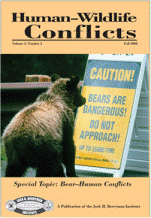Center, Internet, Wildlife Damage Management

Human–Wildlife Interactions
Date of this Version
Fall 2009
Document Type
Article
Abstract
Interactions between humans and cougars (Puma concolor) have been steadily increasing over the past 20 years largely due to human encroachment into cougar habitat and an increase in the human population. We determined the attitudes, knowledge, and perceptions toward cougars by residents in the urban-rural fringe of Calgary, Alberta, Canada, an area populated by both cougars and humans. We sent a survey to a stratified, random sample of 1,508 residents. Survey analysis included a potential for conflict index (PCI) to help provide quantitative direction for future cougar management. We analyzed and tested for differences among 7 variables: livestock ownership, gender, age, education, community of residence, years at residence, and experience with cougars. We found an overall positive attitude toward the presence of cougars in the area. However, residents indicated a low level of knowledge concerning regional wildlife management and wished to be more directly involved in planning and decision making. Recommendations developed from this study included: increasing the awareness of cougars through targeted education, facilitating of stakeholder involvement, developing of proactive cougar management strategies, and exploring adaptive management.


Comments
Published in Human–Wildlife Conflicts 3(2):282–295, Fall 2009. Copyright Jack H. Berryman Institute.